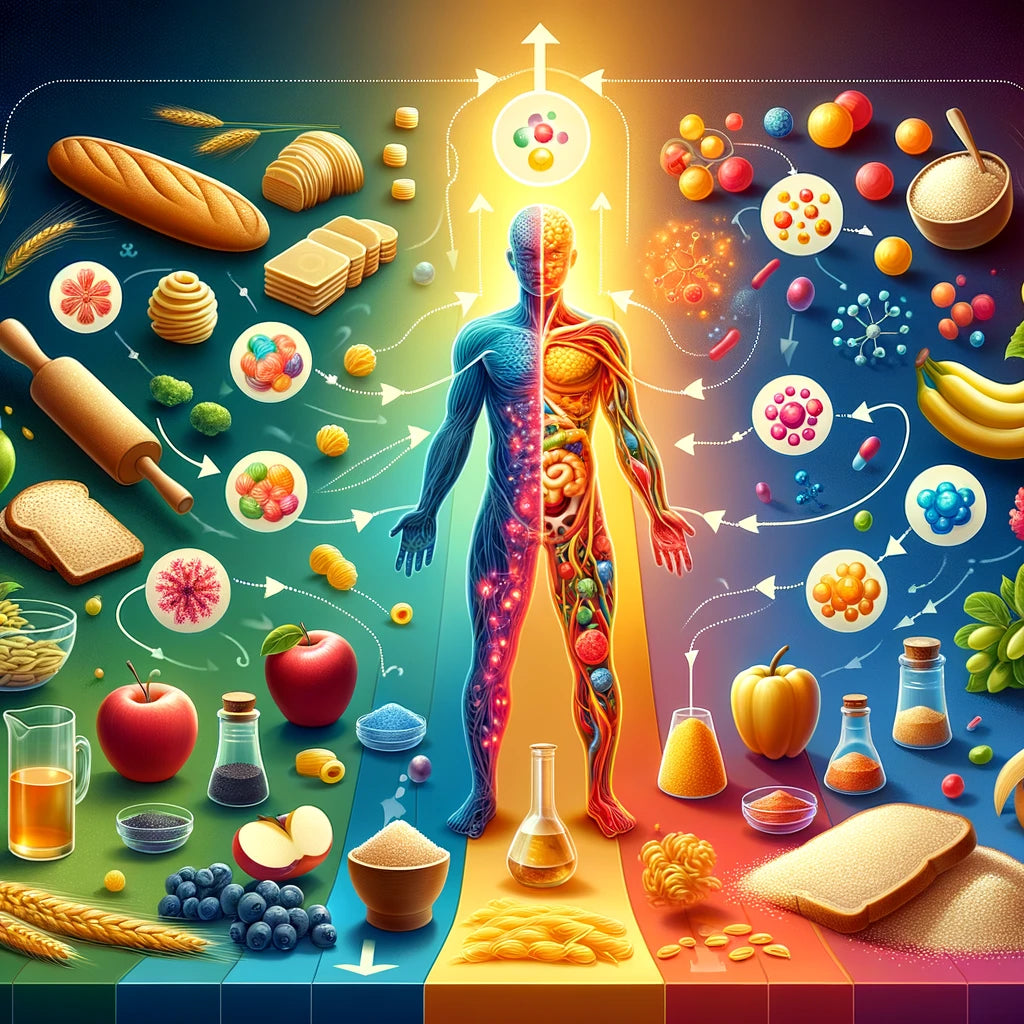Carbohydrates are a fundamental nutrient, essential for the energy supply of the human body, but also the subject of much debate and disagreement in both scientific circles and in popular diets. This article focuses on providing a science-based overview of carbohydrates, intended to provide readers with differing opinions with a neutral, informative viewpoint. Whether you are a proponent of a high-carb diet or believe in the benefits of carbohydrate restriction, the goal is to provide you with reliable information that can help you make an informed judgment about this much-discussed macronutrient.
What are carbohydrates?
Carbohydrates, often referred to as 'carbs', are one of three macronutrients (alongside proteins and fats) that form the basis of our diet. Chemically, carbohydrates consist of carbon (C), hydrogen (H), and oxygen (O) atoms, with the general formula C x (H 2 O) y , where the ratio of hydrogen and oxygen atoms is equal to that in water.
Types of carbohydrates
Carbohydrates can be divided into four main categories, each with unique properties and sources in our diet:
-
Simple carbohydrates (monosaccharides): These are the most basic forms of carbohydrates, which are directly absorbed by the body. Glucose, for example, is a monosaccharide that serves as a primary energy source for cells. Dietary sources: Glucose is commonly found in honey and fruits such as grapes and bananas.
-
Polysaccharides (disaccharides): These consist of two monosaccharides chemically bonded together. Sucrose (table sugar) is a disaccharide consisting of glucose and fructose. Dietary Sources: Table sugar and sweets are rich sources of sucrose, while lactose is mainly found in milk and dairy products.
-
Oligosaccharides: This category consists of short chains of three to ten monosaccharides. Oligosaccharides play a role in the human diet as prebiotics, meaning they promote the growth and activity of beneficial intestinal bacteria. Dietary Sources: Oligosaccharides are found in foods such as garlic, onions, and asparagus.
-
Complex carbohydrates (polysaccharides): These are long chains of monosaccharides, including starch and fiber. They are digested more slowly than simple and complex carbohydrates, which ensures a steady energy supply. Food sources: Starch is abundant in grain products (such as bread and pasta), rice, and potatoes. Fiber is found in vegetables, fruit, nuts, seeds, and whole grain products.
Due to the variety of carbohydrates and their different effects on health, it is important to maintain a balanced intake that both supports the body's nutritional needs and contributes to a healthy gut microbiome.
How the body processes carbohydrates
The process by which the body processes carbohydrates is essential for converting these macronutrients into usable energy. This process can be divided into several steps: digestion, absorption, and metabolism.
1. Digestive process
Carbohydrate digestion begins in the mouth, where the enzyme amylase in the saliva begins breaking down starchy foods into smaller molecules. Once in the stomach, the carbohydrate digestion process is temporarily interrupted by the acidic environment, and then resumes in the small intestine. Here, enzymes such as maltase, sucrase, and lactase continue the breakdown, leaving simple sugars such as glucose, fructose, and galactose.
2. Absorption
These simple sugars are then absorbed through the intestinal wall and into the bloodstream, leading to a rise in blood sugar levels. This signals the pancreas to produce insulin, a hormone essential for blood sugar regulation. Insulin helps transport glucose to cells throughout the body, where it is used for energy or stored for later use as glycogen in muscles and liver.
3. Metabolism
The metabolism of carbohydrates mainly takes place in the liver, where not only glucose is converted into glycogen, but also the conversion of fructose and galactose into glucose can take place. When the body's energy needs are low, the liver can also convert glucose into fat, which is then stored in adipose tissue.
The efficiency of this process and the rate at which carbohydrates are converted into energy can vary depending on several factors, including the type of carbohydrates consumed, the presence of other nutrients in the meal, and individual health status and metabolism.
Well-regulated carbohydrate metabolism is crucial for maintaining healthy energy balance and blood sugar levels. Imbalances in this process can lead to metabolic conditions such as type 2 diabetes, where insulin function is disrupted, resulting in chronically high blood sugar levels.
Although the body is designed to process carbohydrates efficiently, complications can arise at any stage of this process. Abnormalities in the digestion, absorption, or metabolism of carbohydrates can lead to various health problems or be indicative of underlying conditions.
Some examples of potential complications include:
- Digestive disorders , such as lactose intolerance, where the body has difficulty digesting lactose due to a deficiency of the enzyme lactase.
- Insulin resistance , a condition in which the body's cells no longer respond properly to insulin, which can eventually lead to type 2 diabetes.
- Metabolic syndrome , a cluster of conditions including high blood pressure, high blood sugar, excess body fat around the waist, and abnormal cholesterol or triglyceride levels, which together increase the risk of heart disease, stroke, and diabetes.
It is important to be aware of the signs and symptoms that may indicate problems with carbohydrate metabolism. However, we are not medical professionals. If you suspect health problems, especially those related to carbohydrate processing, it is crucial to consult a qualified doctor or dietitian. An expert can make an accurate diagnosis and offer appropriate treatment plans.
In a later article, we will delve deeper into specific diseases and disorders related to carbohydrate metabolism, including their symptoms, causes, and treatment options, to provide a better understanding of the complexity of the body's relationship with carbohydrates.
Glycemic Index and Glycemic Load
The glycemic index (GI) and glycemic load (GL) are both measures designed to understand how different foods affect blood sugar levels. They are especially important in the management of diabetes, but also for anyone who wants to control their blood sugar levels.
Glycemic Index (GI)
The GI is a ranking of carbohydrate foods based on their immediate effect on blood sugar levels. Foods are measured on a scale from 0 to 100, with pure glucose having a reference value of 100. High GI foods (70 and above) are digested and absorbed quickly, resulting in a rapid rise in blood sugar levels. Low GI foods (55 and below), on the other hand, cause a slower and more gradual rise in blood sugar levels.
Examples:
- High GI: White bread, boiled potatoes, and most breakfast cereals.
- Low GI: Lentils, beans, whole grain products, and most fruits.
Glycemic Load (GL)
The GL builds on the GI by taking into account the amount of carbohydrates in a serving of the food, which gives a more accurate picture of how a food affects blood sugar levels. The GL is calculated by multiplying the GI by the amount of carbohydrates per serving (in grams) and dividing this number by 100. A GL of 20 or more is considered high, while a GL of 10 or less is low.
Examples:
- A large apple with a GI of 38 and 25 grams of carbohydrates has a GL of about 10.
- A serving of white rice can have a GI of 73 with 52 grams of carbohydrates, resulting in a GL of about 38.
The application of GI and GL in everyday life can help people make more conscious choices about the carbohydrates they consume, especially when it comes to managing blood sugar levels and avoiding highs and lows that can lead to energy dips and long-term health problems. term.
However, it is important to emphasize that GI and GL are only one aspect of nutritional planning. Other factors, such as overall nutritional value, the presence of fiber, fat, and protein, and individual health goals, should also be considered when making dietary choices.
Effects of excess carbohydrates
Excessive carbohydrate intake, especially from foods with a high glycemic index and load, can have several negative health effects. These effects can range from short-term effects, such as weight gain and blood sugar fluctuations, to long-term complications such as insulin resistance and the increased risk of type 2 diabetes, heart disease and certain cancers.
Short and Long Term Effects
- Weight gain: Carbohydrates that are not directly used by the body as energy are converted into fat and stored. This can lead to weight gain, especially if the intake of high-calorie, low-nutrient carbohydrates is high.
- Blood sugar fluctuations: High GI foods cause rapid spikes in blood sugar followed by sharp drops, which can lead to energy dips and cravings for more sugary foods.
- Insulin resistance: Continued exposure to high blood sugar levels can cause the body's cells to become less sensitive to insulin, increasing the risk of developing type 2 diabetes.
- Increased risk of cardiovascular disease: A diet high in refined carbohydrates and sugar can lead to an increase in bad LDL cholesterol, a decrease in good HDL cholesterol and an increase in triglycerides, all of which are risk factors for cardiovascular disease. vascular diseases.
Pros and cons
While excess carbohydrates can clearly pose health risks, it is important to emphasize that not all carbohydrates are created equal. Complex carbohydrates, such as whole grains, vegetables and fruits, provide essential nutrients and fiber that are important for good health. So it is not only about the amount, but also about the type of carbohydrates that one consumes.
Effects of a carbohydrate deficiency
On the other hand, too little carbohydrate intake can also have negative effects on health. Carbohydrates are the primary energy source for the body, and a deficiency can lead to fatigue, headaches, difficulty concentrating, nutritional deficiencies, and in extreme cases, the breakdown of muscle tissue.
Short and Long Term Effects
- Ketosis: With a very low carbohydrate intake, the body may turn to burning fats as a primary energy source, resulting in the production of ketones. This process, known as ketosis, can aid weight loss but can also lead to side effects such as bad breath, headaches, and fatigue.
- Decreased physical performance: Carbohydrates play a crucial role in energy supply during intensive physical activities. A deficiency can therefore lead to reduced performance and endurance.
- Nutritional Deficiencies: Since many carbohydrate foods are also important sources of vitamins, minerals and fiber, limiting these foods can lead to deficiencies in essential nutrients.
Pros and cons
Moderate reductions in carbohydrate intake, especially refined carbohydrates and sugars, can be beneficial to health and aid in weight management. However, it is important to maintain a balanced intake that provides sufficient energy and nutrients to support overall health and well-being.
Energy Production: Fats vs. Carbohydrates
The human body can obtain energy from various sources, mainly carbohydrates and fats. These energy sources are metabolized in different ways and each has its own efficiency and associated effects on the body, especially in terms of physical activity and performance.
Burning carbohydrates
- Fast energy: Carbohydrates are converted into glucose, which serves as a quick and efficient source of energy. For high-intensity activities such as sprinting or heavy strength training, the body relies primarily on glucose for immediate energy because it can be metabolized quickly to meet rapid energy needs.
- Glycogen storage: Glucose that is not used immediately is stored as glycogen in the muscles and liver. These stores can be quickly used during physical activity, which is essential for endurance performance.
Burning fats
- Sustainable Energy: Fats provide more energy per gram than carbohydrates and are primarily used for low- to moderate-intensity activities. However, the process of converting fats into usable energy (ketones, during ketosis) is slower, making it less suitable for quick energy requirements.
- Ketosis: When the body is in ketosis, a state in which it uses fats as a primary energy source due to low carbohydrate availability, it can take some time to adapt to this new energy source. During this adjustment period, individuals may experience a decrease in energy and physical performance.
Impact on physical performance
The impact of ketosis and fat burning on physical performance can vary depending on the person and the type of activity. For longer, less intense activities, fats can be an efficient source of energy. However, for short, intense activities that require quick energy, a carbohydrate deficiency can lead to reduced performance.
It is important to note that some people can fully adapt to a high-fat, low-carb diet, with improvements in their ability to use fats as fuel during exercise. However, this adjustment may differ individually and take time.
In general, a mixed diet, containing both carbohydrates and fats, is believed to be most beneficial for a wide range of physical activities, supporting both immediate and long-term energy needs.
Determining personal carbohydrate needs
Determining your individual carbohydrate needs is crucial for optimizing your health, well-being and performance, both mentally and physically. These needs can vary significantly depending on several factors, including age, gender, body composition, activity level, personal health goals and metabolic health. Here is a guide to determining which type of carbohydrate consumer you are and how to determine your optimal carbohydrate intake.
1. Evaluate your activity level
- High-intensity and endurance training: Individuals who regularly participate in intense physical activities, such as long-distance running, swimming, or cycling, may need more carbohydrates for optimal performance and recovery.
- Low to moderate activity: For people with a more sedentary lifestyle or who engage in light to moderate activity, a lower carbohydrate intake may be sufficient.
2. Assess your health goals
- Weight loss: Moderate reductions in carbohydrates, especially refined carbohydrates and sugars, can help with weight management.
- Blood sugar management: Individuals with prediabetes, diabetes or insulin resistance may benefit from a lower carbohydrate diet to manage blood sugar levels.
3. Listen to your body
- Energy and well-being: Pay attention to how you feel at different carbohydrate levels. A deficiency can lead to fatigue and a lack of concentration, while an excess can result in energy spikes followed by crashes.
4. Experiment and adapt
- Adjusting Intake: Start with a moderate carbohydrate intake and adjust gradually based on your body responses, activity level and health goals. It may be helpful to keep a food diary or work with a dietitian.
5. Use tools and tests
- Metabolic Testing: For a more personalized approach, some people may opt for metabolic testing, such as an oral glucose tolerance test or insulin responsiveness testing, to see how their body responds to carbohydrates.
General recommendations on the use of carbohydrates
When discussing carbohydrates and their role in our diets, it is inevitable that the topic of different diets and lifestyles comes up. Clearly, there is no one-size-fits-all approach that works for everyone; individual needs and responses to certain diets can vary widely. In future articles we will delve deeper into the scientific basis, pros and cons of various popular diets and lifestyles aimed at managing carbohydrate intake. Some examples of this are:
- Ketogenic diet: A high-fat, very low-carb diet that puts the body into a state of ketosis, where it uses fat as its primary energy source.
- Paleo Diet: Based on the supposed eating habits of our Paleolithic ancestors, this diet focuses on whole foods and limits the intake of processed foods and grains.
- Vegan/Vegetarian Diet: These plant-based diets vary in their restrictions, but can be rich in carbohydrates through higher consumption of fruits, vegetables, legumes and grains.
- Mediterranean Diet: Characterized by high consumption of fruits, vegetables, whole grains, olive oil and moderate amounts of fish and poultry, this diet offers a balanced approach to carbohydrates.
- Low-Carb Diet: There are several variations of low-carb diets that restrict carbohydrate intake to varying degrees to promote weight loss or metabolic health.
Each of these diets has unique properties and can have different effects on health depending on how they are implemented and adapted to individual needs. We'll explore the science behind each diet, who might benefit from it, and how to make healthy choices within each diet.
It is important to emphasize that whatever the diet or lifestyle, choosing high-quality, nutritious carbohydrate sources and maintaining a balanced and varied diet is key. Additionally, remember that consulting with a nutritionist or dietitian can be valuable in developing a diet plan that meets your specific health goals and needs.


